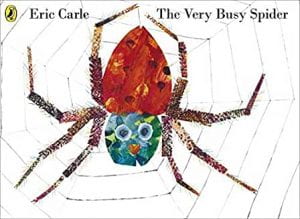Tomorrow, 5th June, is World Environment Day. The theme this year is Reimagine, Recreate, Restore. How to bring about recreation, restoration, and social justice, is addressed by Naomi Klein in her book for young humans, How to change everything, reviewed here. Reimagining starts with looking at the environment and the wonders of nature with a fresh eye, and it is this child-like joy in the natural world that permeates the work of the great Eric Carle, who died a couple of weeks ago, at the age of 91.
“When I was a small boy, my father would take me on walks across meadows and through woods. He would lift a stone or peel back the bark of a tree and show me the living things that scurried about. He’d tell me about the life cycles of this or that small creature, and then he would carefully put the little creature back into its home.”
“I think in my books I honor my father by writing about small living things. And in a way I recapture those happy times.”
His fabulous legacy includes many books exploring the characteristics of living things. The Tiny Seed looks at dispersal and regeneration, growth and change, while other books revel in animal behaviour and body movement with simple words and rich graphics.
 10 little rubber ducks brings to mind the 1992 spill of a container of bath toys, including yellow rubber ducks, which fell overboard into the Pacific Ocean. Over the years, the ducks washed up on several different continents, revealing a worldwide network of currents. The ducks’ story led to a greater understanding of how all our seas are connected and of how plastic pollution is dispersed.
10 little rubber ducks brings to mind the 1992 spill of a container of bath toys, including yellow rubber ducks, which fell overboard into the Pacific Ocean. Over the years, the ducks washed up on several different continents, revealing a worldwide network of currents. The ducks’ story led to a greater understanding of how all our seas are connected and of how plastic pollution is dispersed.
Carle was motivated by art rather than hard facts. His tiny seed grew into a flower taller than the trees and the houses. Explaining why the very hungry caterpillar emerges from a cocoon rather than a chrysalis, he wrote on his website:
“When I was a small boy, my father would say, ‘Eric, come out of your cocoon’. He meant I should open up and be receptive to the world around me.”
“For me, it would not sound right to say, ‘Come out of your chrysalis,’” he continued, “and so poetry won over science!”
Nonetheless, his much-treasured books have brought the wonders of the natural world to countless children. The Very Hungry Caterpillar has sold more than 55 million copies around the world since it was first published in 1969, translated into more than 70 languages. It is one of more than 70 books that Eric Carle published over his career, laying down wonderful memories for older generations and bringing joy for generations to come.






